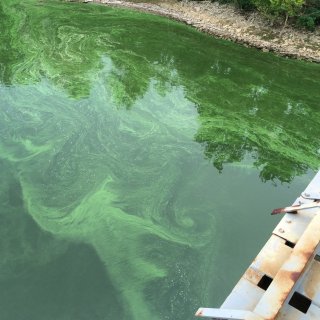Harmful Algal Blooms and Algal Toxins Webinar
About the Webinar

1. HAB Technical Assistance in El Salvador
This presentation provides an overview of technical assistance provided to the Government of El Salvador’s drinking water agency, ANDA in 2020 due to a harmful algal bloom that caused widespread taste and odor complaints in El Salvador’s capital city of San Salvador. Tom Waters, of EPA’s Office of Ground Water and Drinking Water’s Technical Support Center traveled to San Salvador in February 2020 (just before the pandemic) to conduct an initial assessment of San Salvador’s surface water treatment plant and related drinking water infrastructure, meet with ANDA representatives and operators, and provide technical assistance related to HABs. El Salvador is a U.S. trade partner as a member of the U.S. – Central America and Dominican Republic Free Trade Agreement (CAFTA-DR) and EPA serves as the lead U.S. government agency to provide environmental technical assistance under the agreement. The presentation demonstrates how lessons-learned from working with U.S. utilities on drinking water treatment optimization for HABs was leveraged to assist international partners.
Presenter: Tom Waters, P.E., EPA's Office of Water. Tom is an environmental engineer with the U.S. EPA Office of Ground Water and Drinking Water, Technical Support Branch in Cincinnati, OH. He works on EPA’s drinking water optimization program, providing technical assistance to primacy agencies and water systems, with a particular focus on water treatment for cyanobacteria and their associated cyanotoxins, membrane treatment, and distribution system optimization. Tom is a licensed professional engineer in Ohio with 15 years of experience in drinking water treatment and distribution.
2. Cyanobacterial Blooms Dynamics as Determined by Nucleic Acid Based Techniques
This presentation discusses the molecular monitoring approaches used in applied environmental microbiology studies conducted in our laboratories. The presentation primarily focuses on the detection and quantification of cyanobacterial groups and cyanotoxin genes implicated in harmful algal blooms. Results from next generation sequence analysis and qPCR/RT-qPCR methods used to characterize toxic cyanobacterial populations, associated bacterial communities, and geographically localized genotypes (strains) will be discussed. We show how we can monitor functional genes associated with nutrients (i.e., nitrogen cycle) to detect cyanobacteria and potentially predict early warning of toxin production in environmental settings. Examples of other environmental and engineering research studies using molecular tools are also discussed.
Presenter: Jorge Santo Domingo, Ph.D., EPA's Office of Research and Development. For the past 25 years he has worked in molecular microbial ecology projects related to drinking water, wastewater, recreational waters, fecal pollution, antibiotic resistance, biosolids, and cyanobacterial blooms. Jorge was one of 65 fellows elected to the American Academy of Microbiology Class of 2022.
